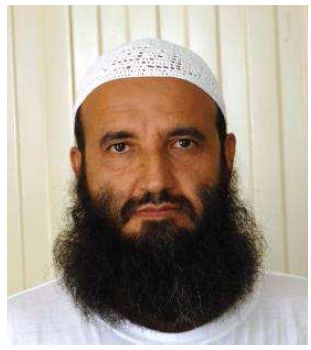Salah Abdul Rasool Al Blooshi is a Bahraini, who was held in extrajudicial detention in the United States Guantanamo Bay detainment camps, in Cuba.
The Al Farouq training camp, also called Jihad Wel al-Farouq, was a Taliban and Al-Qaeda training camp near Kandahar, Afghanistan. Camp attendees received small-arms training, map-reading, orientation, explosives training, and other training. Nasir al-Bahri reported that the camp was only established following the arrival of Egyptian Islamic Jihad and Egyptian Islamic Group militants who had suitable expertise as to provide training to others.
Al Wafa is an Islamic charity listed in Executive Order 13224 as an entity that supports terrorism. United States intelligence officials state that it was founded in Afghanistan by Adil Zamil Abdull Mohssin Al Zamil, Abdul Aziz al-Matrafi and Samar Khand. Affiliated groups include The Taliban and Al Qaeda.
Mishal Awad Sayaf Alhabiri is a citizen of Saudi Arabia, who was held in extrajudicial detention in the United States Guantanamo Bay detention camps, in Cuba. His Guantanamo Internment Serial Number was 207. American intelligence analysts estimate he was born in 1980, in Minawara, Saudi Arabia.

Said Salih Said Nashir is a citizen of Yemen, held in extrajudicial detention in the United States Guantanamo Bay detainment camps, in Cuba. His Internment Serial Number is 841.

Awal Gul was a citizen of Afghanistan who died in the United States's Guantanamo Bay detention camps in Cuba after nine years of imprisonment without charge.

Abdul Haq Wasiq is the Director of Intelligence of the Islamic Emirate of Afghanistan since September 7, 2021. He was previously the Deputy Minister of Intelligence in the former Taliban government (1996–2001). He was held in extrajudicial detention in the Guantanamo Bay detainment camps, in Cuba, from 2002 to 2014. His Guantanamo Internment Serial Number was 4. American intelligence analysts estimate that he was born in 1971 in Ghazni Province, Afghanistan.
Shawali Khan is a citizen of Afghanistan, who had been held in extrajudicial detention in the United States Guantanamo Bay detainment camps, in Cuba. His Guantanamo Internment Serial Number is 899. American intelligence analysts estimate he was born in 1963, in Kandahar, Afghanistan.
Abdallah Saleh Ali Al Ajmi was a Kuwaiti citizen, who was held in extrajudicial detention in the United States Guantanamo Bay detainment camps, in Cuba. His Guantanamo Internment Serial Number was 220. Joint Task Force Guantanamo counter-terrorism analysts reports indicated that he was born on 2 August 1978, in Almadi, Kuwait.

Mullah Abdul Rauf Aliza, widely identified as Mullah Abdul Rauf Khadim, was an Afghan militant who served as a senior leader in both the Taliban and ISIS-K.
Ali Abdul Motalib Awayd Hassan Al Tayeea is a citizen of Iraq who was held in extrajudicial detention in the United States's Guantanamo Bay detention camps, in Cuba. His Guantanamo Internment Serial Number was 111. The Department of Defense reports that Al Tayeea was born in Baghdad, Iraq. The Department of Defense provided a birthday, or an estimated year of birth, for all but 22 of the 759 detainees. Al Tayeea is one of those 22. He was repatriated on January 17, 2009, after more than seven years without ever been charged.

Mohammed Fenaitel Mohamed Al Daihani is a citizen of Kuwait who was held in extrajudicial detention in the United States Guantanamo Bay detention camp, in Cuba. Al Daihani's Guantanamo Internment Serial Number was 229. Joint Task Force Guantanamo counter-terrorism analysts reports that Al Daihani was born on November 4, 1965, in Kuwait City, Kuwait. Al Dehani was repatriated without charges on November 2, 2005.
Jawad Jabber Sadkhan is a citizen of Iraq who was held in extrajudicial detention in the United States Guantanamo Bay detainment camps, in Cuba. Sadkhan's Guantanamo Internment Serial Number was 433.
Abdul Majid Muhammed is a citizen of Iran who was held in extrajudicial detention in the United States Guantanamo Bay detention camp in Cuba.

Haji Ghalib is a citizen of Afghanistan who was held in extrajudicial detention in the United States Guantanamo Bay detention camps, in Cuba. His Guantanamo Internment Serial Number was 987. Guantanamo counter-terrorism analysts estimate he was born in 1963, in Nangarhar, Afghanistan. Ghalib was repatriated on February 28, 2007.
Mahmud Salem Horan Mohammed Mutlak Al Ali is a citizen of Syria, best known for the more than eight years he spent in the Guantanamo Bay detention camps in Cuba after being classified as an enemy combatant by the United States. His Guantanamo Internment Serial Number was 537. Joint Task Force Guantanamo counter-terrorism analysts report that Mahmud Salem Horan Mohammed Mutlak Al Ali was born on 5 May 1974, in Doha, Qatar. He and Palestinian Ohmed Ahmed Mahamoud Al Shurfa were released to Germany on 16 September 2010.

Abdul Latif Nasir is a Moroccan man formerly held in administrative detention in the United States Guantanamo Bay detention camps, in Cuba. His Guantanamo Internment Serial Number was 244. Joint Task Force Guantanamo counter-terrorism analysts report he was born on March 4, 1965, in Casablanca, Morocco. Abdul Latif Nasir and Sufyian Barhoumi tried to file emergency requests to be transferred from Guantanamo in the final days of Barack Obama's presidency.

Mullah Noorullah Noori is the Minister of Borders and Tribal Affairs of the Islamic Emirate of Afghanistan since 7 September 2021. He was also the Taliban's Governor of Balkh Province during their first administration (1996–2001). Noorullah Noori spent more than 12 years in extrajudicial detention in the United States's Guantanamo Bay detention camps, in Cuba. Noori was released from the detention camp on May 31, 2014, in a prisoner exchange that involved Bowe Bergdahl and the Taliban Five, and flown to Qatar.







